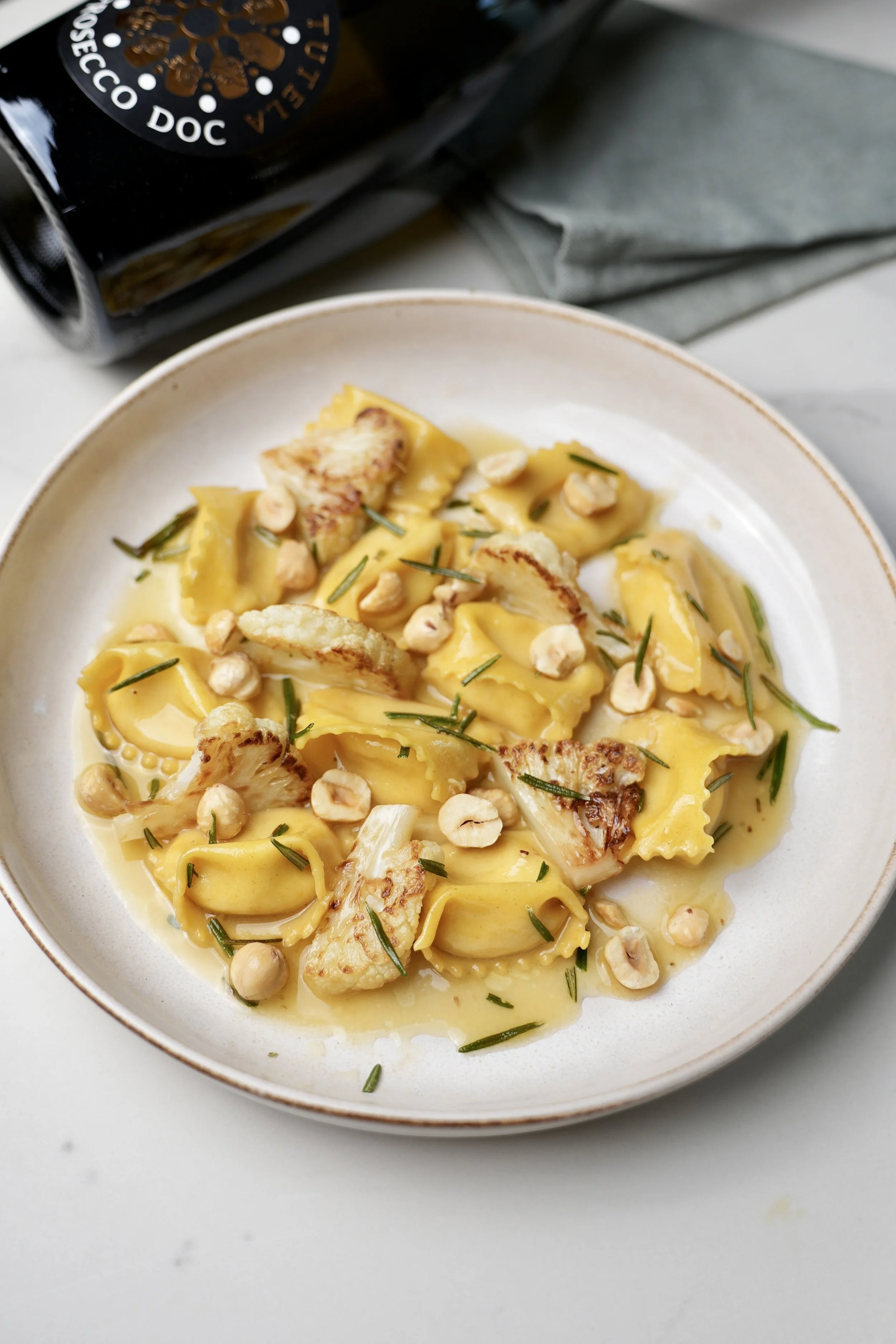Cauliflower Agnolotti
Agnolotti al cavolfiore con nocciole e Prosecco DOC - Testo Italiano in fondo alla pagina
Growing up, like 99% of kids I disliked cauliflower. How can I blame myself for it! If you look at it, it is kind of scary and if you just boil it with no love shown to it, it doesn’t have a lot of appeal.
Now, I can confidently say that cauliflower is one of my fav veggies ever. So versatile, it welcomes the use of spices, herbs and cheese, and the texture of this vegetable is phenomenal as it changes completely based on the way you cook it. My favourite way to use it is to make it into a cheesy puree, and when it’s made very thick you have actually made a great filling for pasta, like these agnolotti (a classic from Piedmont).
These agnolotti marry very well with hazelnuts and the flavour of fried rosemary and the dish pairs beautifully with the mild acidity of Prosecco DOC Brut, here also used to deglaze the pasta sauce.
Chef’s tip: I often make a large batch of agnolotti and freeze them straight away on baking parchment. Once frozen keep them in a sealed bag and let them defrost again by spreading on parchment before cooking them as normal.
Serves – About 4 // Prep time – 60 minutes
Ingredients:
1 small cauliflower
30 gr of unsalted butter
1 small white onion
2 tbsp of 00 flour
100 ml of cream
50 gr of grated Grana Padano cheese
1 sprig of rosemary
20 gr of toasted hazelnuts
2 garlic cloves
30 ml of Prosecco DOC
2 tbsp of olive oil
Salt and pepper to taste
For the pasta
2 egg
120 gr of egg yolks
400 gr of 00 flour
Extra flour to dust
Method
To prepare the cauliflower filling, cut it into florets, reserve some to roast and use as garnish and boil the rest in salted water. Meanwhile chop and brown the onion in a pan with a drizzle of oil and a knob of butter and after 10 minutes when slightly caramelised add 2 tablespoons of flour as if you were creating a roux (the thickening agent for the bechamel sauce). Cook and mix the flour for 2 minutes with the onion (and its fats) then toss in the cooked cauliflower. Add the cream, cover with a lid and cook until soft. If it looks too soupy keep cooking without the lid until most of the water is evaporated. Season with salt and pepper and blend while still warm with the grated cheese until smooth. Pass it through a sieve if necessary and let it cool a few hours in the fridge.
For the pasta, beat the eggs with a fork and incorporate the flour gradually. When the ingredients start to bind together knead by hand with energy. Remember, during this step it is important to stretch and pull your dough while kneading to allow the flour’s gluten to start working and therefore obtain and elastic dough. After a few minutes of working it will slowly come together and result in a smooth and homogeneous dough. As not all eggs are the same, if your dough feels too sticky to your hands, feel free to add a spoon of flour, if too dry and not binding, you can add a touch of egg white leftover or even a splash of water.
When ready, wrap your dough in film and leave to rest for about 30 minutes, this will allow the dough to ‘relax’ to prevent it being too elastic when shaping your pasta.
Proceed to roll the dough into thin pasta sheets. If you have a wooden board great, if you don’t a clean, flat surface will work. Slice the pasta into thick sheets and flatten them with a rolling pin. With the help of a pasta machine, roll the pasta out. (This can also be done by hand using a rolling pin and elbow grease as well).
It is good practice to fold your rolled pasta on itself and start over a couple of times, this process with give you a smooth rectangular sheet that will be easier to work with at a later stage. Pass the pasta gradually from the largest setting to the narrower settings and remember to dust with extra flour but only if it feels too wet and humid on your hands.
To shape the agnolotti you need quite a thin pasta sheet, I would say pass it twice to the second to last setting of the machine (about 1.5 mm). As showed in the video, with the help of a pastry bag place a long log of the filling onto the pasta sheet then roll it on itself making sure to get all the air out to avoid ‘pockets’. Now seal the edges with your hands and press your fingers across the filling to create about 2 cm large dollop of filling. Now use a pastry wheel to trim the excess pasta and to cut between those dollops and there you have your agnolotti. This process is much easier to understand if watched on video, I assure you.
To create the quick dressing fry the garlic and rosemary in a spoonful of olive oil until golden then remove them but retain the crispy rosemary to use as garnish later. Now in the same pan brown on both side the nice, retained florets of cauliflower, season to taste and add a knob of butter to fully caramelise them. Remove them from the pan and deglaze it immediately with a splash of Prosecco DOC and let it reduce on the stove for 1 minute.
At this stage drop the agnolotti in salted boiling water, cook them for no more than 1 minute and toss them gently into the pan with the dressing. Mix around without breaking the pasta and add a splash of pasta water to create a creamy emulsion. Plate the agnolotti straight away along with the sauce, garnish with the caramelised cauliflower florets and the toasted hazelnuts and sprinkle with the crispy rosemary.
Remember to enjoy it with a cold glass of Prosecco DOC, preferably Brut style.
RICETTA IN ITALIANO
1 cavolfiore piccolo
30 gr di burro non salato
1 cipolla bianca piccola
2 cucchiai di farina 00
100 ml di panna
50 gr di formaggio Grana Padano grattugiato
1 rametto di rosmarino
20 gr di nocciole tostate
2 spicchi d'aglio
30 ml di Prosecco DOC
2 cucchiai di olio d'oliva
Sale e pepe q.b.
Per la pasta
2 uova
120 gr di tuorli d'uovo
400 gr di farina 00
Farina extra per spolverare
Procedimento
Per preparare il ripieno di cavolfiore, tagliatelo a cimette, tenetene alcune da arrostire e usare come guarnizione e fate bollire il resto in acqua salata. Nel frattempo tritate e fate rosolare la cipolla in una padella con un filo d'olio e una noce di burro e dopo 10 minuti quando sarà leggermente caramellata aggiungete 2 cucchiai di farina come se steste creando un roux (l'addensante per la besciamella). Cuocete e mescolate la farina per 2 minuti con la cipolla (e i suoi grassi) quindi aggiungete il cavolfiore cotto. Aggiungete la panna, coprite con un coperchio e fate cuocere finché non sarà morbida. Se sembra troppo liquida continuate a cuocere senza coperchio finché non sarà evaporata la maggior parte dell'acqua. Condite con sale e pepe e frullate ancora calda con il formaggio grattugiato fino a ottenere un composto liscio. Se necessario passatelo al setaccio e fatelo raffreddare qualche ora in frigo.
Per la pasta sbattete le uova con una forchetta e incorporate gradualmente la farina. Quando gli ingredienti iniziano a legarsi tra loro impastate a mano con energia. Ricordate che in questa fase è importante allungare e tirare l'impasto mentre si impasta per permettere al glutine della farina di iniziare a lavorare e quindi ottenere un impasto elastico. Dopo qualche minuto di lavorazione, l'impasto si amalgamerà lentamente e si otterrà un impasto liscio e omogeneo. Poiché non tutte le uova sono uguali, se l'impasto risulta troppo appiccicoso alle mani, sentiti libero di aggiungere un cucchiaio di farina, se è troppo asciutto e non legante, puoi aggiungere un tocco di albume avanzato o anche un goccio d'acqua.
Quando è pronto, avvolgi l'impasto nella pellicola e lascialo riposare per circa 30 minuti, questo permetterà all'impasto di "rilassarsi" per evitare che sia troppo elastico quando dai forma alla pasta. Procedi a stendere l'impasto in sottili sfoglie di pasta. Se hai una tavola di legno, va bene, altrimenti andrà bene anche una superficie pulita e piana.
Taglia la pasta in sfoglie spesse e appiattiscile con un mattarello. Con l'aiuto di una macchina per la pasta, stendi la pasta. (Questo può essere fatto anche a mano usando un mattarello e olio di gomito). È buona norma ripiegare la pasta arrotolata su se stessa e ricominciare un paio di volte, questo procedimento ti darà una sfoglia rettangolare liscia che sarà più facile da lavorare in seguito.
Passa gradualmente la pasta dall'impostazione più grande a quella più stretta e ricorda di spolverare con altra farina, ma solo se ti sembra troppo bagnata e umida sulle mani. Per dare forma agli agnolotti hai bisogno di una sfoglia di pasta piuttosto sottile, direi di passarla due volte alla penultima impostazione della macchina (circa 1,5 mm).
Come mostrato nel video, con l'aiuto di una tasca da pasticcere metti un lungo rotolo di ripieno sulla sfoglia di pasta, quindi arrotolalo su se stesso assicurandoti di far uscire tutta l'aria per evitare "tasche". Ora sigilla i bordi con le mani e premi le dita sul ripieno per creare un ciuffo di ripieno di circa 2 cm di larghezza. Ora usa una rotella per tagliare la pasta in eccesso e tagliare tra quei ciuffi e hai i tuoi agnolotti. Questo procedimento è molto più facile da capire se guardato in video, te lo assicuro.
Per creare il condimento veloce, soffriggere l'aglio e il rosmarino in un cucchiaio di olio d'oliva fino a doratura, quindi rimuoverli ma conservare il rosmarino croccante per usarlo come guarnizione in seguito. Ora nella stessa padella rosolare da entrambi i lati i bei fiori di cavolfiore conservati, aggiustare di sale e aggiungere una noce di burro per caramellarli completamente. Toglierli dalla padella e sfumare immediatamente con un goccio di Prosecco DOC e lasciar ridurre sul fuoco per 1 minuto.
A questo punto, immergere gli agnolotti in acqua bollente salata, cuocerli per non più di 1 minuto e saltarli delicatamente nella padella con il condimento. Mescolare senza rompere la pasta e aggiungere un goccio di acqua di cottura per creare un'emulsione cremosa. Impiattate subito gli agnolotti insieme alla salsa, guarnite con i fiori di cavolfiore caramellati e le nocciole tostate e cospargete con il rosmarino croccante.


